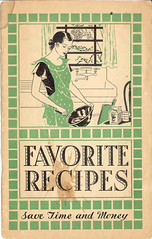Mom Help! Dad's Cooking Again!By Joe Bingham

"Dear Lord, we thank you for this food, and we ask you to bless it --- especially tonight because Daddy cooked it. Amen."
All right, so perhaps I'm not quite as good of a cook as my wife. You have to understand, though, back in the old days, when I was single, there really wasn't much of a demand for me to do any cooking.
My main foods at that time were cereal, peanut butter, pizza, and burritos. Not all together, of course --- well maybe in certain combinations --- but generally I ate them separately.
Now, suddenly, I'm married with four kids and...
Well, I guess that didn't exactly happen suddenly, but...
Anyway, my wife and I both work, but since I work at home I'm often the one that does the cooking.
I had to do some learning in the beginning. I remember my wife used to come into the kitchen while I was cooking and say, "Smells like you scorched the food."
About the first ten times this happened, I just sort of ignored her. Eventually, however, I got curious.
"What do you mean by 'scorching'?" I asked.
"Scorching is when the food on the bottom of the pan sticks and burns to an inedible crisp," she answered coldly. It seemed to me she was implying that it was a bad thing, too.
"It makes the whole pot full taste burned," she continued with a look of disgust on her face. To which I replied, "What? You can prevent that?"
After that, I started taking a few lessons from her on how to cook. She taught me about stirring the food while it's in the pot, not cooking everything on high, greasing pans before putting food in them, blowing the foam off of the pot when the macaroni starts boiling over, and other advanced techniques. Eventually, I started getting pretty good at a few things so I decided to try something a little more complicated.

I tried making bread.
Now, I'm really good at making biscuits. In fact, they are one of my specialties, but they're not quite as complicated as making bread.
First, there was this whole idea of "kneading" the bread. My wife came up to me just after I'd broken my second wooden spoon while trying to stir more flour into an already thick lump of dough.
"No, no, no!" she cried, obviously distressed over the death of the spoon. "You are supposed to KNEAD the bread!"
"Of course I NEED the bread!" I replied. "Why do you think I'm making it?"
However, it's the whole idea of letting it "raise" that has proven to be the most difficult for me to master. You wouldn't think it would be all that hard. I mean, all that is required is to simply let the dough sit around by itself for a while. And in fact, that's really not the problem. It's the coming back on time later that I find so challenging.
The last time I tried to make bread I set it aside to let it raise, just like I was supposed to do, and went about my business.
Some time later, I just happened to be walking through the kitchen when I noticed this giant balloon sitting in a bread pan with a towel thrown over the top of it.
"What have the kids done now?" I thought to myself as I lifted the towel. "Oh yeah! I'm making bread today," I concluded.
I hadn't noticed that the recipe was called "Balloon Bread", but apparently that's what it was. So, I threw it in the oven and proceeded to cook it. A giant loaf of bread for all my hungry kids to feed on for a few days sounded good to me.
Some time later, I just happened to be walking through the kitchen past the oven when I thought to myself, "Why is it so hot over here? What have the kids been messing with now?"
"Oh yeah! I'm cooking bread today!" I corrected myself.
Amazingly, it wasn't burned, too badly anyway. You see, once in a while I just happen to come along at roughly the right time. In the end, though, I wasn't all that impressed with the Balloon Bread recipe. To be honest, it tasted more like sour air than bread. I don't really remember pumping it full of carbon dioxide myself, but I'd swear that was what was in there. Hmmm, carbonated bread. What will they think of next?
One day, however, I decided to put forth a tremendous effort into my bread making. I worked hard, set timers so I'd remember what I was doing, and everything. Plus, I scrapped the Carbonated Balloon Bread recipe, and went with one from another cook book.
In the end, I had what I thought was a rather decent product. It was of normal size, not burned, and I could even cut it with a regular bread knife instead of a hacksaw this time.
So, I asked my kids for their opinion, after coaxing them into eating it with a promise of ice cream afterward, of course. On a scale from one to ten, they gave me a resounding two.
I've since gone back to making biscuits.
Then there's cookies. I love making cookies. I'm really fairly good at making cookies, too. At least, I used to be. That was before my kids all decided they wanted to learn to make cookies, too. (This may have had something to do with the fact that only the cook, being me, was ever allowed to eat any of the cookie dough.)
Sure, it's fun to have my kids "help" me make cookies. It's just that, well, with an average of 2-3 helpers, sometimes I get a little confused.
"OK kids, we're making a double batch of cookies so there's enough for us all. Now, the recipe says we need 2 cups of flour, so doubled that's..."
"Can I put in the flour?"
"No, I want to put in the flour."
"Dad already said I could help him!"
"Well, I can help him, too!"
"Wait a minute, you can both help. One of you get the flour, and one of you get the sugar."
"I'll get the sugar!"
"No, I'll get the sugar!"
"We need the flour first actually."
"I know, I'm getting it."
"How much flour, Dad?"
"Well, let's see 2 cups doubled is..."
"I'm putting it in, give me the cup!"
"I went and got it! You wanted to do the sugar."
"Fine, but I'm going to put in the eggs."
"How much flour, Dad?"
"...3 cups. Now get me two eggs and a cup of sugar."
"I've got the eggs."
"You can't crack them right. You'll get shells in the cookies."
"No, I won't. How many eggs, Dad?"
"I said one cup. Now, somebody get the baking salt and the soda."
"Which kind? Root Beer or Sprite?"
"What?"
Anyway, you can see how it goes sometimes, but honestly, I USED to be quite good at making cookies.
Meanwhile, my kids are still growing, so I must be doing something right. Either that or they are sneaking food out of the storage room while I'm asleep.
Ah, but let me tell you about the most amazing product on the market today. It's one that no cooking dad should be without.
It's called a slow cooker, also known as a Crock Pot.
These things are amazing! You can throw anything you want in them, turn them on, come back anywhere from 6-9 hours later, and it still tastes good!
I don't recommend waiting for 12 hours to return, however. If you do, DO NOT stir the bottom of the pot. I know it's tempting, but after 12 hours the food on the bottom of the pot is best left for the dishwasher. I know it sounds confusing, but it has something to do with that "scorching" thing again --- I think.
My wife is the best, though. She makes everything taste good, except for mushrooms, but then that's impossible. She usually doesn't even look at the directions on anything either. I guess it's all just natural with her.
There is one area of cooking that I'm MUCH better at handling than she is, however, and that's grease fires. She doesn't handle those well, especially when they occur inside the frying pan while she happens to be holding on to it. I know she tries, but I've never known throwing, running, and screaming to be very effective in such situations.
But then, that's another story for another time. (Preferably sometime when there's absolutely NO chance my wife will be around to read it.)

 Now that you have some basic knowledge about cookware set materials, think about how you cook. You will want to make sure the cookware sets you consider have the pots and pans you need for your style of cooking.
Now that you have some basic knowledge about cookware set materials, think about how you cook. You will want to make sure the cookware sets you consider have the pots and pans you need for your style of cooking. The decision on which cookware set to buy is based on your cooking styles. If you care more about convenience and appearance, consider a matched set of cookware. If you care more about the quality of the cooking process, consider mixing cookware pieces and metals such as cast iron skillets, copper sauce and saute pans, stainless steel stock pots and aluminum / anodized aluminum frying pans.
The decision on which cookware set to buy is based on your cooking styles. If you care more about convenience and appearance, consider a matched set of cookware. If you care more about the quality of the cooking process, consider mixing cookware pieces and metals such as cast iron skillets, copper sauce and saute pans, stainless steel stock pots and aluminum / anodized aluminum frying pans.






































